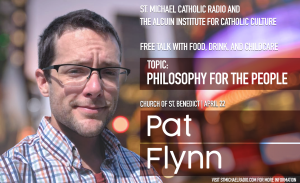SPECIAL REPORT: Catholic Radio Achievements in Serving America’s 381 Metropolitan Areas
Special Report:
CATHOLIC RADIO ACHIEVEMENTS IN SERVING AMERICA’S 381 METROPOLITAN AREAS
NOTE: KPIM (102.9fm St. Michael Catholic Radio) registered and helped the growth by 3.39%. Download the table at the end of the article and see rank #55)
The White House Office of Management & Budget (OMB) continually monitors the growth of America’s metropolitan areas, defined as any metropolitan area of a city and adjacent countryside and towns that has a population of 50,000 or greater. The 2014 Estimates for Metropolitan Areas, which OMB calls the Metropolitan Statistical Areas (MSA), are available on Wikipedia. After the magnanimous honor and esteem shown me by EWTN and everyone present at the recent Catholic Radio Conference in Birmingham, I felt that I ought to repay everyone in some way, and the thought of expanding and updating my database of Catholic Radio According to American MSA came to mind. This past weekend, I devoted considerable hours to doing so. This database, along with others, was lost when my two-year- old hard drive failed this spring. Reconstructing a database of 381 entries is more time-consuming than difficult, but it’s the least I can do to show gratitude.
What’s the purpose of this database? Twofold. First, here is visible, statistical proof that Catholic radio has been enormously successful in the last 17 years in reaching millions of Americans. Second, we can clearly see those metropolitan areas where there is yet no Catholic radio service; such are targets.
So exactly how well are you folks doing in bringing Catholic radio to Americans living in metropolitan areas? Extraordinarily well, as a matter of fact. The most stunning evidence is in the Top 50 MSA, whereby 44 of these metro areas are covered by a good Catholic signal—an 88% achievement. Looking at the Top 100 MSA, Catholic radio serves 86 out of the Top 100 MSA—an achievement rate of 86%— leaving only 14 unserved metro areas in the Top 100.
The following table shows just how well you are doing:
|
MSA Rank |
Pop., Running Total |
Served |
% Served |
Unserved |
|
1-50 |
174,885,904 |
44 |
88% |
6 |
|
51-100 |
212,489,417 |
36 |
72% |
14 |
|
101-200 |
247,247,982 |
71 |
71% |
29 |
|
201-300 |
264,106,631 |
65 |
65% |
35 |
|
301-381 |
277,134,766 |
43 |
53% |
38 |
|
Totals |
277,134,766 |
259 |
69.8% |
122 |
The population estimates are for 2014 and the total is running, as can be seen by examining the increasing totals for each additional segment of the 381 MSA in the country. Notice that the percentages of MSA served in each of the segments is quite respectable, ranging from 53% in the 81 smallest metro areas to 88% in the Top 50 metro areas. Catholic radio is therefore present on average in about 70% of all other segments of the MSA. Clearly, there is, especially on the part of the proponents and accomplishers of Catholic radio development and those people living in the larger metropolitan areas, where there are more resources and people likely to back the endeavor to bring and maintain a Catholic radio service, a studied intent to bring Catholic radio first to the largest metropolitan areas.
This is not to deny the importance of the smaller metropolitan areas or the rural areas, where there are significant numbers of Catholic stations. In fact, it has been my observation that the most rapid growth has been in the last 17 years in those metropolitan areas in the second rank, that is, Nos. 51 through 100. Here the prices are not the astronomical ones existing in the Top 50 market, where Catholic radio has been slower to penetrate. For the last five years or so, nevertheless, we have seen the remarkable growth of Catholic stations in the largest 50 metropolitan areas—New York, Chicago, Los Angeles, Washington, Boston, for example.
There are still six major metropolitan areas in the Top 50 that do not yet have Catholic radio—Atlanta (No. 9), Baltimore (No. 20), Charlotte (No. 22), Orlando (No. 26), Memphis (No. 41), and Richmond (No. 44). Every one of these metropolitan areas is in the Bible Belt where there are few Catholics— except for Baltimore. Efforts existed in the past to bring Catholic radio to Atlanta, Charlotte, Orlando, and an LPFM in the first window to a Memphis suburb, but that CP was never built. As for Baltimore, the old Catholic Radio Network associated with Father Fessio leased a station on 1570 AM, but with the demise of that old network—not to be confused with the identically named network run by the O’Laughlins out of Kansas City—the lease was terminated.
Why is the MSA measuring stick of Catholic radio progress important? In other words, cover all 381 metro areas and you will cover almost nine out of then Americans. The total estimated population of the United States in 2014 was 318.9 million people. The sum total of all 381 metropolitan areas comes to 277,134,766 people. That means that 86.9% of the American population lives in one of these 381 metropolitan areas. These 381 MSA add up to over 277 million Americans, roughly 87% of all Americans in 2014. In other words, cover all 381 metro areas and you will cover almost nine out of then Americans. As of October 31st, Catholic radio serves 259 of these 381 OMB-defined metropolitan areas, roughly 68.68%. In the 17 years since Mother Angelica began promoting Catholic radio stations, Radio Maria came to this country with a handful of stations backed by the World Family in Italy, and Mark Follett and his group began Relevant Radio, this is quite an achievement. My hat off to all of you who have made this possible!
Explanatory notes to the following table of 381 Metropolitan Areas and Catholic Radio.
Some station call signs are repeated twice or more. That’s because certain stations, particularly in the East, Midwest, and on the California coast, cover more than one MSA even though they are licensed to only a particular one. A good example is Holy Family Radio’s WHYF in south-central Pennsylvania.
In general, I have, for other than the Top 100 MSA, shortened the often lengthy names of these OMB areas to keep the table less cluttered. Where towns are well known, I have not added the State behind it, unless there is confusion as in which State the city in question is located—Springfield is a good example. There are many Springfields in the U.S., particularly the ones in Massachusetts, Illinois, and Missouri.
LPFM stations are noted as such. Where the call sign has not yet been granted, these are indicated simply by generic designation. To keep this table simple in construction, I have not sought to identify CP’s not on the air or to distinguish Spanish-language stations. Other sources will clarify these matters.
“P” indicates a station in the planning or project stage that I know about. Some of the metropolitan areas are in the gunsights of at least one Catholic group, but I prefer to designate with “P” those markets in which a new Catholic station seems a good chance of coming about in the near future. (In one metro area, I have deleted the “P” because the group concerned wants their efforts kept quiet.)
Finally, although I have spent many an hour on this project and have meticulously checked each of the 381 metropolitan areas, doubling the research in uncertain metro areas, it nevertheless is reality that a work of this magnitude will include some errors or absences, no matter how careful I have been. I am much obliged if the knowledgeable people tell me about these; if the corrections are sufficient in number, I will issue a revised table.
You can click here to download the report CRU #778 Special Issue


